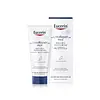What's inside
What's inside
 Key Ingredients
Key Ingredients

 Benefits
Benefits

 Concerns
Concerns

 Ingredients Side-by-side
Ingredients Side-by-side

Water
Skin ConditioningUrea
BufferingLanolin
EmollientCetearyl Alcohol
EmollientParaffinum Liquidum
EmollientGlyceryl Stearate
EmollientDecyl Oleate
EmollientPEG-20 Stearate
EmulsifyingParaffin
PerfumingPhenoxyethanol
PreservativeSodium PCA
HumectantButyrospermum Parkii Butter
Skin ConditioningAllantoin
Skin ConditioningGlycolic Acid
BufferingPanthenol
Skin ConditioningTocopheryl Acetate
AntioxidantBenzyl Alcohol
PerfumingMelaleuca Alternifolia Leaf Oil
AntioxidantArginine
MaskingAloe Barbadensis Leaf Juice
Skin ConditioningParfum
MaskingWater, Urea, Lanolin, Cetearyl Alcohol, Paraffinum Liquidum, Glyceryl Stearate, Decyl Oleate, PEG-20 Stearate, Paraffin, Phenoxyethanol, Sodium PCA, Butyrospermum Parkii Butter, Allantoin, Glycolic Acid, Panthenol, Tocopheryl Acetate, Benzyl Alcohol, Melaleuca Alternifolia Leaf Oil, Arginine, Aloe Barbadensis Leaf Juice, Parfum
Water
Skin ConditioningUrea
BufferingGlycerin
HumectantCetearyl Alcohol
EmollientCaprylic/Capric Triglyceride
MaskingGlyceryl Stearate
EmollientEthylhexyl Cocoate
EmollientHydrogenated Coco-Glycerides
EmollientOctyldodecanol
EmollientSodium Lactate
BufferingGlyceryl Stearate Se
EmulsifyingDistarch Phosphate
AbsorbentCeramide NP
Skin ConditioningLactic Acid
BufferingArginine Hcl
Skin ConditioningSodium PCA
HumectantCholesterol
EmollientHelianthus Annuus Seed Oil
EmollientAlanine
MaskingCarnitine
CleansingGlycine
BufferingSodium Chloride
MaskingDimethicone
EmollientCarbomer
Emulsion StabilisingSorbitan Stearate
EmulsifyingSodium Cetearyl Sulfate
CleansingPhenoxyethanol
PreservativeWater, Urea, Glycerin, Cetearyl Alcohol, Caprylic/Capric Triglyceride, Glyceryl Stearate, Ethylhexyl Cocoate, Hydrogenated Coco-Glycerides, Octyldodecanol, Sodium Lactate, Glyceryl Stearate Se, Distarch Phosphate, Ceramide NP, Lactic Acid, Arginine Hcl, Sodium PCA, Cholesterol, Helianthus Annuus Seed Oil, Alanine, Carnitine, Glycine, Sodium Chloride, Dimethicone, Carbomer, Sorbitan Stearate, Sodium Cetearyl Sulfate, Phenoxyethanol
 Reviews
Reviews

Ingredients Explained
These ingredients are found in both products.
Ingredients higher up in an ingredient list are typically present in a larger amount.
Cetearyl alcohol is a mixture of two fatty alcohols: cetyl alcohol and stearyl alcohol. It is mainly used as an emulsifier. Emulsifiers help prevent the separation of oils and products. Due to its composition, it can also be used to thicken a product or help create foam.
Cetearyl alcohol is an emollient. Emollients help soothe and hydrate the skin by trapping moisture.
Studies show Cetearyl alcohol is non-toxic and non-irritating. The FDA allows products labeled "alcohol-free" to have fatty alcohols.
This ingredient is usually derived from plant oils such as palm, vegetable, or coconut oils. There is debate on whether this ingredient will cause acne.
Due to the fatty acid base, this ingredient may not be Malassezia folliculitis safe.
Learn more about Cetearyl AlcoholGlyceryl Stearate is a mix of glycerin and stearic acid.
It is used to stabilize the mixing of water and oil ingredients. By preventing these ingredients from separating, it can help elongate shelf life. It can also help thicken the product's texture.
As an emollient, it helps soften skin and supports barrier-replenishing ingredients.
In cosmetics, Glyceryl Stearate is often made from vegetable oils or synthetically produced.
This ingredient may not be fungal-acne safe
Fun fact: The human body also creates Glyceryl Stearate naturally.
Learn more about Glyceryl StearatePhenoxyethanol is a preservative that has germicide, antimicrobial, and aromatic properties. Studies show that phenoxyethanol can prevent microbial growth. By itself, it has a scent that is similar to that of a rose.
It's often used in formulations along with Caprylyl Glycol to preserve the shelf life of products.
Sodium PCA is the sodium salt of pyroglutamic acid. It is naturally occurring in our skin's natural moisturizing factors where it works to maintain hydration.
The PCA stands for pyrrolidone carboxylic acid, a natural amino acid derivative.
This ingredient has skin conditioning, anti-inflammatory, and humectant properties. Humectants help hydrate your skin by drawing moisture from the air. This helps keep your skin moisturized.
Learn more about Sodium PCAUrea is also called carbamide and is the diamide of carbonic acid. In cosmetics, urea is used to hydrate the skin. It also provides exfoliation in higher concentrations.
As a humectant, urea helps draw moisture from the air and from deep within the skin. This helps hydrate your skin. Studies show urea is an effective moisturizer for dry skin conditions. 40% urea is typical in medications for treating eczema and other skin conditions.
Urea has the strongest exfoliation effect in concentrations higher than 10%. It is a keratolytic agent, meaning it breaks down the keratin protein in the top layer of skin. This helps remove dead skin cells and flaking skin.
In medicine, urea has been shown to help increase the potency of other ingredients, such as fungal treatments.
Humans and animals use urea to metabolize nitrogen-containing compounds. Urea is highly soluble in water. Once dissolved, it is neither acidic nor alkaline.
Learn more about UreaWater. It's the most common cosmetic ingredient of all. You'll usually see it at the top of ingredient lists, meaning that it makes up the largest part of the product.
So why is it so popular? Water most often acts as a solvent - this means that it helps dissolve other ingredients into the formulation.
You'll also recognize water as that liquid we all need to stay alive. If you see this, drink a glass of water. Stay hydrated!
Learn more about Water